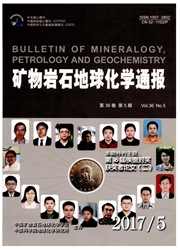

 中文摘要:
中文摘要:
为揭示中国东部中生代大规模岩石圈减薄作用的深部地慢地球化学响应,对华北东部5个地区的中生代玄武岩进行了ICP-MS分析。结果表明,119~125Ma玄武岩不仅具显著分异的稀土元素组成(La/Yb=35~60)、岛弧玄武岩型微量元素分布特征,且具高Ni(210×10^-6~510×10^-6)和Cr(510×10^-6~1400×10^-6)含量、高Mg^#(71~78),以及系统高于球粒陨石的Nb/Ta值E19.9±1.0(10),n=16];而100Ma碱锅玄武岩具有与球粒陨石(17.6)接近的Nb/Ta值E17.3±0.2(10)]。再循环地壳岩石在金红石稳定域内以榴辉岩为残余的部分熔融体+地幔橄榄岩反应,不仅使地幔岩石熔点降低、获得高Nb/Ta值及石榴子石特征,而且橄榄石向辉石的转变反应使Ni和Cr在交代地幔中的总分配系数显著降低。受熔体交代地幔橄榄岩的部分熔融可合理解释119~125Ma玄武岩的上述地球化学特征,玄武岩Nb/Ta值应是对岩石圈减薄过程中地壳物质返回地慢后熔融产生硅质熔(流)体对上覆地幔交代的直接地球化学记录。
 英文摘要:
英文摘要:
Mesozoic basalts from East China were analyzed by ICP-MS to reveal the geochemical response of the deep mantle to the Mesozoic lithospheric thinning. The results indicate that the 119-125 Ma basalts show not only remarkably fractionated rare earth elements (La/Yb = 35-60), island arc-type trace element compositions, but also high Ni (210 × 10^-6 - 510 × 10^-06 ) and Cr (510 × 10^-6 - 1400 × 10^-6 ) contents and high Mg^# (71 - 78) and Nb/Ta ratios E19.9 ±1.0(1σ), n= 16). In contrast, the 100 Ma Jianguo basalts have Nb/Ta ratio of 17. 3 ±0. 2(1σ) similar to that of the chondrite (17. 6 ). Mantle metasomatism, caused by silicate melt derived from rutile-bearing eclogite, would not only reduce the solidus of mantle, impress garnet feature and high Nb/Ta ratio on the mantle, but also decrease remarkably the partition coefficients of Ni and Cr due to transformation of olivine to pyroxene. Geochemical features of the 119-125 Ma basalts can be well explained by partial melting of such metasomatized mantle. High Nb/Ta ratios of the basalts could directly record the mantle metasomatism by silicate melt derived from the recycled mafic lower crust in association with the Mesozoic lithospheric thinning.
 同期刊论文项目
同期刊论文项目
 同项目期刊论文
同项目期刊论文
 Direct determination of tellurium in geological samples by inductively coupled plasma mass spectrome
Direct determination of tellurium in geological samples by inductively coupled plasma mass spectrome Elemental and Sr–Nd–Pb isotopic geochemistry of Late Paleozoic volcanic rocks beneath the Junggar ba
Elemental and Sr–Nd–Pb isotopic geochemistry of Late Paleozoic volcanic rocks beneath the Junggar ba Tectonic Evolution of Metasediments from the Gangdise Terrane, Asian Plate, Eastern Himalayan Syntax
Tectonic Evolution of Metasediments from the Gangdise Terrane, Asian Plate, Eastern Himalayan Syntax Mesozoic adakites in the Lingqiu Basin of the central North China Craton: Partial melting of underpl
Mesozoic adakites in the Lingqiu Basin of the central North China Craton: Partial melting of underpl Zircon U–Pb ages and Hf isotope compositions of migmatite from the North Dabie terrane in China: con
Zircon U–Pb ages and Hf isotope compositions of migmatite from the North Dabie terrane in China: con Timing of UHP metamorphism in the Hong’an area, western Dabie Mountains, China: evidence from zircon
Timing of UHP metamorphism in the Hong’an area, western Dabie Mountains, China: evidence from zircon Simultaneous in-situ determination of U-Pb age and trace elements in zircon by LA-ICP-MS in 20(m spo
Simultaneous in-situ determination of U-Pb age and trace elements in zircon by LA-ICP-MS in 20(m spo U-Pb zircon ages, geochemical and isotopic compositions of granitoids in Songpan-Garze fold belt, ea
U-Pb zircon ages, geochemical and isotopic compositions of granitoids in Songpan-Garze fold belt, ea Recycling deep cratonic lithosphere and generation of intraplate magmatism in the North China craton
Recycling deep cratonic lithosphere and generation of intraplate magmatism in the North China craton A-type granite and adakitic magmatism association in Songpan-Garze fold belt, eastern Tibetan Platea
A-type granite and adakitic magmatism association in Songpan-Garze fold belt, eastern Tibetan Platea Geochemical and Pb-Sr-Nd isotopic compositions of Indosinian granitoids from the Bikou block, northw
Geochemical and Pb-Sr-Nd isotopic compositions of Indosinian granitoids from the Bikou block, northw Geochemistry and magmatic history of eclogites and ultramafic rocks from the Chinese continental sci
Geochemistry and magmatic history of eclogites and ultramafic rocks from the Chinese continental sci Origin of the Toongshankou porphyry-skarn Cu-Mo deposit, eastern Yangtze craton (China): geochronolo
Origin of the Toongshankou porphyry-skarn Cu-Mo deposit, eastern Yangtze craton (China): geochronolo Zircon U–Pb age and trace element evidence for Paleoproterozoic granulite-facies metamorphism and Ar
Zircon U–Pb age and trace element evidence for Paleoproterozoic granulite-facies metamorphism and Ar Volume-optional and low-memory (VOLM) chamber for laser ablation-ICP-MS: application to ?ber analyse
Volume-optional and low-memory (VOLM) chamber for laser ablation-ICP-MS: application to ?ber analyse A local aerosol extraction strategy for the determination of the aerosol composition in laser ablati
A local aerosol extraction strategy for the determination of the aerosol composition in laser ablati Mineral chemistry of peridotites from Paleozoic, Mesozoic and Cenozoic lithosphere: Constraints on m
Mineral chemistry of peridotites from Paleozoic, Mesozoic and Cenozoic lithosphere: Constraints on m Simultaneous determinations of U–Pb age, Hf isotopes and trace element compositions of zircon by exc
Simultaneous determinations of U–Pb age, Hf isotopes and trace element compositions of zircon by exc Reply to the comment by Zhang et al. on: “First finding of A-type and adakitic magmatism association
Reply to the comment by Zhang et al. on: “First finding of A-type and adakitic magmatism association Recycled crust controls contrasting source compositions of Mesozoic and Cenozoic basalts in the Nort
Recycled crust controls contrasting source compositions of Mesozoic and Cenozoic basalts in the Nort Accurate determination of rare earth elements in USGS, NIST SRM and MPI-DING glasses by excimer lase
Accurate determination of rare earth elements in USGS, NIST SRM and MPI-DING glasses by excimer lase Geochronology of the Pengjiakuang and Rushan Gold Deposits, Eastern Jiaodong Gold Province, Northeas
Geochronology of the Pengjiakuang and Rushan Gold Deposits, Eastern Jiaodong Gold Province, Northeas Interaction of adakitic melt-peridotite: Implications for the high-Mg# signature of Mesozoic adakiti
Interaction of adakitic melt-peridotite: Implications for the high-Mg# signature of Mesozoic adakiti Timing of the Wudangshan, Yaolinghe volcanic sequences and mafic sills in South Qinling: U-Pb zircon
Timing of the Wudangshan, Yaolinghe volcanic sequences and mafic sills in South Qinling: U-Pb zircon 期刊信息
期刊信息
